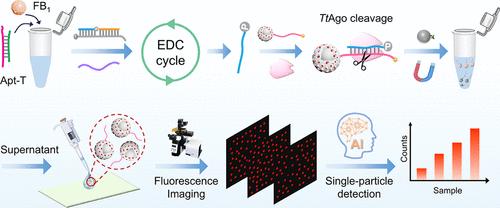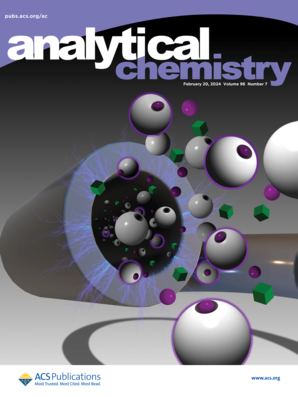Deep Learning-Assisted Fluorescence Single-Particle Detection of Fumonisin B1 Powered by Entropy-Driven Catalysis and Argonaute
IF 6.7
1区 化学
Q1 CHEMISTRY, ANALYTICAL
引用次数: 0
Abstract
Timely and accurate detection of trace mycotoxins in agricultural products and food is significant for ensuring food safety and public health. Herein, a deep learning-assisted and entropy-driven catalysis (EDC)-Argonaute powered fluorescence single-particle aptasensing platform was developed for ultrasensitive detection of fumonisin B1 (FB1) using single-stranded DNA modified with biotin and red fluorescence-encoded microspheres as a signal probe and streptavidin-conjugated magnetic beads as separation carriers. The binding of aptamer with FB1 releases the trigger sequence to mediate EDC cycle to produce numerous 5′-phosphorylated output sequences, which can be used as the guide DNA to activate downstream Thermus thermophilus Argonaute (TtAgo) for cleaving the signal probe, resulting in increased number of fluorescence microspheres remaining in the final reaction supernatant after magnetic separation. Subsequently, through fast and accurate counting of red bright particles in the captured confocal fluorescence images from the supernatant via a YOLOv9 deep learning model, the sensitive and specific detection of FB1 could be realized. This approach has a limit of detection (LOD) of 0.89 pg/mL with a linear range from 1 pg/mL to 100 ng/mL, and satisfactory recovery (87.2–113.5%) in real food samples indicates its practicality. The integration of the aptamer and EDC with TtAgo broadens the target range of Argonaute and enhances sensitivity. Furthermore, incorporating deep learning significantly improves the analytical efficiency of single-particle detection. This work provides a promising analytical strategy in biosensing and promotes the application of fluorescence single-particle detection in food safety monitoring.

求助全文
约1分钟内获得全文
求助全文
来源期刊

Analytical Chemistry
化学-分析化学
CiteScore
12.10
自引率
12.20%
发文量
1949
审稿时长
1.4 months
期刊介绍:
Analytical Chemistry, a peer-reviewed research journal, focuses on disseminating new and original knowledge across all branches of analytical chemistry. Fundamental articles may explore general principles of chemical measurement science and need not directly address existing or potential analytical methodology. They can be entirely theoretical or report experimental results. Contributions may cover various phases of analytical operations, including sampling, bioanalysis, electrochemistry, mass spectrometry, microscale and nanoscale systems, environmental analysis, separations, spectroscopy, chemical reactions and selectivity, instrumentation, imaging, surface analysis, and data processing. Papers discussing known analytical methods should present a significant, original application of the method, a notable improvement, or results on an important analyte.
 求助内容:
求助内容: 应助结果提醒方式:
应助结果提醒方式:


